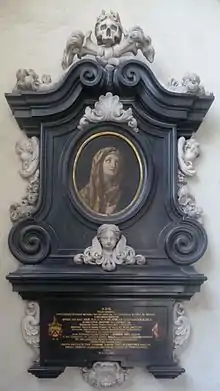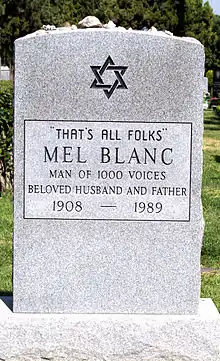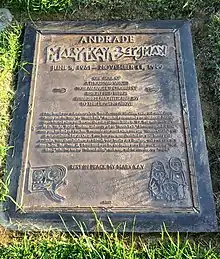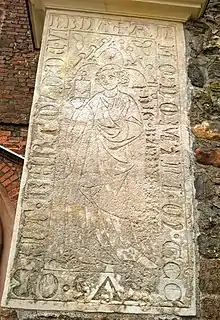Epitaph
An epitaph (from Greek ἐπιτάφιος epitaphios "a funeral oration" from ἐπί epi "at, over" and τάφος taphos "tomb")[1][2] is a short text honoring a deceased person. Strictly speaking, it refers to text that is inscribed on a tombstone or plaque, but it may also be used in a figurative sense. Some epitaphs are specified by the person themselves before their death, while others are chosen by those responsible for the burial. An epitaph may be written in prose or in poem verse; poets have been known to compose their own epitaphs prior to their death, as did William Shakespeare.[3]

Most epitaphs are brief records of the family, and perhaps the career, of the deceased, often with a common expression of love or respect—for example, "beloved father of ..."—but others are more ambitious. From the Renaissance to the 19th century in Western culture, epitaphs for notable people became increasingly lengthy and pompous descriptions of their family origins, career, virtues and immediate family, often in Latin. Notably, the Laudatio Turiae, the longest known Ancient Roman epitaph, exceeds almost all of these at 180 lines; it celebrates the virtues of an honored wife, probably of a consul.
Some are quotes from holy texts, or aphorisms. One approach of many epitaphs is to 'speak' to the reader and warn them about their own mortality. A wry trick of others is to request the reader to get off their resting place, inasmuch as the reader would have to be standing on the ground above the coffin to read the inscription. Some record achievements (e.g., past politicians note the years of their terms of office). Nearly all (excepting those where this is impossible by definition, such as the Tomb of the Unknown Soldier) note name, year or date of birth, and date of death. Many list family members and the relationship of the deceased to them (for example, "Father / Mother / Son / Daughter of").
Epitaphs in England
Medieval era

Stock phrases or standard elements present in epitaphs on mediaeval church monuments and ledger stones in England include:
- Hic jacet.. (here lies...)
- ... cuius animae propitietur deus amen (generally abbreviated to cuius aie ppitiet ds ame with tildes indicating the omitted letters) ("whose soul may God look upon with favour Amen")
- Memoriae sacrum ... / MS ("Sacred to the memory (of) ...")
Modern era
- Requiescat in pace / RIP ("may he rest in peace")
Notable examples
| Wikiquote has quotations related to: Epitaphs |
Poets, playwrights and other writers
While you live, shine
have no grief at all
life exists only for a short while
and Time demands his due.
This is my father's crime against me, which I myself committed against none.
Good frend for Iesvs sake forebeare,
To digg the dvst encloased heare.
Bleste beman
spares thes stones,
And cvrst be hemoves my bones.
(In modern spelling):
Good friend for Jesus's sake forbear,
To dig the dust enclosed here.
Blessed be the man that spares these stones,
And cursed be he that moves my bones.
Here lies One whose Name was writ in Water
Cast a cold eye
On life, on death.
Horseman, pass by!
Sleep after toyle, port after stormie seas,
Ease after warre, death after life, does greatly please.
Homo sum! the adventurer
Against you I will fling myself, unvanquished and unyielding, O Death!
Statesmen
Looking into the portals of eternity teaches that
The brotherhood of man is inspired by God's word;
Then all prejudice of race vanishes away.
Oh God (Devanagari: हे राम)
Mathematicians
I've finally stopped getting dumber.
(Hungarian: Végre nem butulok tovább.)
We must know. We will know.
(German: Wir müssen wissen. Wir werden wissen.)
Soldiers
Go tell the Spartans, stranger passing by
that here, obedient to their law, we lie.
Here sleeps at peace a Hampshire Grenadier
Who caught his early death by drinking cold small beer.
Soldiers, be wise at his untimely fall,
And when you're hot, drink strong or none at all.
To save your world you asked this man to die:
Would this man, could he see you now, ask why?
There is borne an empty hearse
covered over for such as appear not.
Heroes have the whole earth for their tomb.
Entertainers
And the beat goes on.
That's all folks!
I told you I was ill.
(Irish: Dúirt mé leat go raibh mé breoite.)
Other
He never killed a man that did not need killing.
Monuments with epitaphs
 Epitaph painted by Guidon Reni, for the knight van Ertborn de Witte
Epitaph painted by Guidon Reni, for the knight van Ertborn de Witte
 Epitaph for heart of Frédéric Chopin
Epitaph for heart of Frédéric Chopin Grave of W. B. Yeats; Drumecliff, Co. Sligo
Grave of W. B. Yeats; Drumecliff, Co. Sligo Lengthy epitaph for Johann Wauer a (German pastor), died 1728, concluding with a short Biblical quotation
Lengthy epitaph for Johann Wauer a (German pastor), died 1728, concluding with a short Biblical quotation The epitaph on voice actor Mel Blanc's tombstone
The epitaph on voice actor Mel Blanc's tombstone Inscription at Heather O'Rourke's crypt
Inscription at Heather O'Rourke's crypt Ezzatollah Sahabi, Glory of Iran and his patriotic daughter Haleh
Ezzatollah Sahabi, Glory of Iran and his patriotic daughter Haleh A folksy epitaph to an English village blacksmith in Houghton, Cambridgeshire, UK
A folksy epitaph to an English village blacksmith in Houghton, Cambridgeshire, UK The gravestone of comedian, writer and actor Spike Milligan showing the notable epitaph
The gravestone of comedian, writer and actor Spike Milligan showing the notable epitaph Grave of Mary Kay Bergman, at Forest Lawn Memorial Park (Hollywood Hills). Note that it features etchings of characters she voiced on South Park.
Grave of Mary Kay Bergman, at Forest Lawn Memorial Park (Hollywood Hills). Note that it features etchings of characters she voiced on South Park.
In music
In a more figurative sense, the term may be used for music composed in memory of the deceased. Igor Stravinsky composed in 1958 Epitaphium for flute, clarinet and harp. In 1967 Krzysztof Meyer called his Symphony No. 2 for choir and orchestra Epitaphium Stanisław Wiechowicz in memoriam. Jeffrey Lewis composed Epitaphium – Children of the Sun for narrator, chamber choir, piano, flute, clarinet and percussion. In 1969, King Crimson released the song Epitaph, giving a reference to epitaphs within the song. Bronius Kutavičius composed in 1998 Epitaphium temporum pereunti. Valentin Silvestrov composed in 1999 Epitaph L.B. (Епітафія Л.Б.) for viola (or cello) and piano. In 2007 Graham Waterhouse composed Epitaphium for string trio as a tribute to the memory of his father William Waterhouse. The South African poet Gert Vlok Nel wrote an (originally) untitled song, which appeared on his first music album 'Beaufort-Wes se Beautiful Woorde' as 'Epitaph', because his producer Eckard Potgieter told him that the song sounded like an epitaph. David Bowie's final album, Blackstar, released in 2016, is generally seen as his musical epitaph, with singles "Blackstar" and "Lazarus" often singled out.
In space
In the late 1990s, a unique epitaph was flown to the moon along with the ashes of geologist and planetary scientist Eugene Shoemaker.[13] At the suggestion of colleague Carolyn Porco, Shoemaker's ashes were launched aboard the Lunar Prospector spacecraft on January 6, 1998.[14] The ashes were accompanied by a laser-engraved epitaph on a small piece of foil.[13] The spacecraft, along with the ashes and epitaph, crashed on command into the south polar region of the moon on July 31, 1999.
See also
References
- ἐπιτάφιος. Liddell, Henry George; Scott, Robert; A Greek–English Lexicon at the Perseus Project
- "Online Etymology Dictionary: Epitaph". Etymonline.com. Retrieved 2012-03-18.
- Photograph of William Shakespear's grave, 3 June 2007
- Landels, John G. 1999. Music in Ancient Greece and Rome. London and New York: Routledge. ISBN 9780415167765 (cloth); ISBN 9780415248433 (pbk); ISBN 9780203042847 (ebook)
- Blankinship, Kevin (2015-09-20). "An Elegy by al-Ma'arri". Jadaliyya. Retrieved 2020-05-04.
- Charles Dickens (1893). Dickens' Dictionary Of The Thames. p. 269.
- Woolf, Virginia (1931), The Waves, Berlin: Harcourt
- Biswas, Debasis. The Great Mathematicians. Lulu.com. ISBN 9781105381386 – via Google Books.
- "Famous Epitaph on Unknown Soldier tomb stone". Famousquotes.me.uk. Retrieved 2012-03-18.
- Thucydides (1843). "History of the Peloponnesian War 2.34.3". In Molesworth, William (ed.). The English works of Thomas Hobbes of Malmesbury. VIII. Thomas Hobbes (translator). London: John Bohn. p. 188. Available online at the Perseus Project.
- Thucydides (1910). "2.43.3". The Peloponnesian War. Translated by Richard Crawley. London, New York: J. M. Dent; E. P. Dutton. Available online at the Perseus Project.
- "Milligan gets last laugh on grave". BBC News Online. 2004-05-24. Retrieved 2015-06-08.
- Porco, Carolyn. "The Eugene M. Shoemaker Tribute". Diamond Sky Productions. Retrieved 8 June 2013.
- Porco, Carolyn C. (February 2000). "Destination Moon". Astronomy. Retrieved 8 June 2013.
Bibliography
- Vidor, Gian Marco (2014). Satisfying the mind and inflaming the heart: emotions and funerary epigraphy in nineteenth-century Italy. Mortality (Routledge), on-line edition. http://www.tandfonline.com/eprint/fByCJS8IEiui62NK5wrq/full#.U_HCzFOBq3o
- Bertrand, Régis (2005). Que de vertus. Les épitaphes édifiantes des débuts du XIXe siècle. In R. Bertrand, A. Carol, & J.-N. Pelen (Eds.), Les narrations de la mort (pp. 241–255). Aix-en-Provence: Publications de l’Universite´ de Provence.
- Guthke, K. S. (2003). Epitaph culture in the west. Variations on a theme in cultural history. Lewiston, NY: Mellen.
External links
- Imperial War Museum. "What is the Kohima Epitaph?". archive.iwm.org.uk. Archived from the original on 30 December 2014. Retrieved 4 April 2013.
- Kohima Epitaph